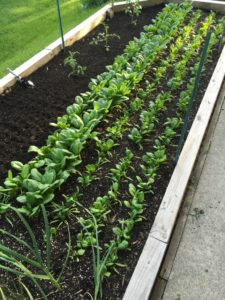
Content created in partnership with The U.S. Farmers and Ranchers Alliance.
When my kids were toddlers (they are in college now), my husband and I took on gardening as a way to save on groceries and teach our kids an appreciation for how our food is grown. But what was supposed to be a lesson for them, turned out to be a life-long lesson for the entire family.
I was always curious about how my food was grown, how long it took to arrive at the grocery store and the challenges in between. This prompted me to learn more about agriculture. In my quest, I learned the top most important things farmers do to ensure there is food to feed millions and our environment remains protected.
Here are my top findings:
- Farmers use precision tools to improve crop yields
While we worry about what to make for dinner each day, farmers have the difficult task of preventing malicious insects, weeds and plant diseases from attacking the very crops we rely on. Drought, insects and disease can seriously devastate yields, if farmers don’t take key measures. Farmers incorporate many precise management tools, including genetically engineered (GE) seeds that are resistant to specific herbicides and pests. GE seeds require fewer inputs (like water or pesticides) needed to grow food, on less land than ever before.
- Farmers are great stewards of our land
While visiting a canola oil farm recently, I realized the care that farmers put into preserving the land. Farmers are extremely watchful of preserving natural resources such as water, soil and the environment. Many farmers have tanks to collect rain water, they recycle lots of end products from their crops for animal feed and make sure their crop protection measures are safe for the environment as well as for them and their workers, which are usually all family members.
- Farmers use modern technology
Farming is a family affair and a high-tech space. It’s important for farmers to use techniques and methods that are efficient and more sustainable for the land, like modern tractors which cut labor, time and waste. For example, something as planting the seeds by hand can now be done more efficiently, precise and much faster with a piece of equipment that can do it in a matter of hours. Leaving more time for the farmer to spend with his family.
Seeing my husband pour his energy in our garden after a long day at work and the kids’ expressions as we were picking our harvest was an experience I will never forget. If there is a “must do” advice I can pass on to other families is to plant a garden with your family.
Here are the ABC’s of starting a garden:
Sunshine
Choose a spot in your yard that gets between 6 to 8 hours of sunshine and decide what herbs, veggies or fruits you want to grow. I started with herbs such as basil, rosemary, cilantro and oregano, then graduated to vegetables like lettuce, spinach, peppers, cucumbers, carrots, tomatoes and even corn and pumpkins!
Soil
As someone who likes to recycle everything, I love saving my food scraps to mix them with soil and grass clippings to enrich our soil. However, there are many compost variations even some that include coffee grounds!
The most important thing about your soil is to make sure your soil is appropriate for your crop. There are apps such as the burpee app or website (http://www.burpee.com/gardenadvicecenter) that can guide you as to what to plant in your region, what spot to choose and friendly reminders of when to plant them and much more.
Seeds
Picking your crops depends on personal interest, but also in your soil. There are crops that do better in certain soils and climates, so make sure to check with the app or a reputable website that can guide you in planting the best crops for your region. However, at the end of the day it is a trial and error.
Water
Although we like hassle free activities, planting and tending to a vegetable garden is something that requires lots of attention. I would love to plant something and let it grow by itself, but unfortunately weeds are one of those plants that grow overnight and compete for space and nutrients in my yard, and since we don’t eat them I need to tend to my delicious crops on a daily basis, except when there is rain. Rain (not a storm) will become your best friend when you have a garden.
Harvest
There is nothing more gratifying than picking your harvest and eating your own foods that you and your family planted. Eating my harvest means I am eating them at the ripening point – when they are more delicious and robust in flavor as well as when they are in season. Nothing better than eating corn in July or tomatoes in august!
Below is a recipe that I created with my very own tomatoes:
Fresh Marinara Sauce
8 medium fresh tomatoes, cut in wedges
1/2 medium onion, cut in wedges
1/2 cup basil leaves
4 to 5 garlic cloves
1 teaspoon dried oregano or 1/4 cup fresh oregano leaves
1 tablespoon olive or canola oil
1 teaspoon salt, optional
Directions:
Place all ingredients in a large slow cooker and set on high for 4 to 6 hours. Let cool for at least 1/2 hour or overnight in the refrigerator. Transfer prepared sauce, in small batches, to blender. Blend until all ingrediets are blend to desired consitency. Serve over your favorite pasta dishe or freeze in medium freezer bags.
Makes about 8 cups

